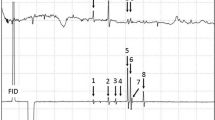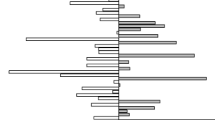Abstract
Mating disruption is a valuable tool for the management of pest lepidopteran species in many agricultural crops. Many studies have addressed the effect of female pheromone on the ability of males to find calling females but, so far, fewer have addressed the effect of pheromone on the mating behavior of females. We hypothesized that mating of female moth species may be adversely affected following sex pheromone auto-exposure, due to abnormal behavioral activity and/or antennal sensitivity. Our results indicate that, for Grapholita molesta and Pandemis pyrusana females, copulation, but not calling, was reduced following pre-exposure to sex pheromone. In contrast, for Cydia pomonella and Choristoneura rosaceana, sex pheromone pre-exposure did not affect either calling or copulation propensity. Adaptation of female moth antennae to their own sex pheromone, following sex pheromone auto-exposure, as measured by electroantennograms, occurred in a species for which identical exposure reduced mating success (G. molesta) and in a species for which such exposure did not affect mating success (C. rosaceana). These results suggest that pre-exposure of female moths of certain species to sex pheromone may further contribute to the success of pheromone-based mating disruption. Therefore, we conclude that, in some species, mating disruption may include a secondary mechanism that affects the mating behavior of female moths, in addition to that of males.

Similar content being viewed by others
References
Ansebo L., Ignell R., Lofqvist J., and Hansson B. S. 2005. Responses to sex pheromone and plant odours by olfactory receptor neurons housed in sensilla auricillica of the codling moth, Cydia pomonella (Lepidoptera: Tortricidae). J. Insect Physiol. 51:1066–1074.
Anton S., Varela N., Avilla J., and Gemeno C. 2011. Ordinary glomeruli in the antennal lobe of male and female tortricid moth Grapholita molesta (Busck) (Lepidoptera: Tortricidae) process sex pheromone and host-plant volatiles. J. Exp. Biol. 214:637–645.
Baker T. C. and Cardé R. T. 1979a. Courtship behavior of the oriental fruit moth (Grapholitha molesta)(Lepidoptera-Tortricidae)- experimental analysis and consideration of the role of sexual selection in the evolution of courtship pheromones in the Lepidoptera. Ann. Entomol. Soc. Am. 72:173–188.
Baker T. C. and Cardé R. T. 1979b. Analysis of pheromone-mediated behaviors in male Grapholitha molesta, the oriental fruit moth (Lepidoptera, Tortricidae). Environ. Entomol. 8:956–968.
Baker T. C., Willis M. A., Haynes K. F., and Phelan P. L. 1985. A Pulsed Cloud of Sex Pheromone Elicits Upwind Flight in Male Moths. Blackwell Publishing Ltd. p 257–265.
Bates S. L., Zhao J. Z., Roush R. T., and Shelton A. M. 2005. Insect resistance management in GM crops: past, present and future. Nat. Biotechnol. 23:57–62.
Birch M. C. 1977. Response of Both Sexes of Trichoplusia ni (Lepidoptera: Noctuidae) to Virgin Females and to Synthetic Pheromone. Blackwell Publishing Ltd. p 99–104.
Cardé R. T. and Minks A. K. 1995. Control of moth pests by mating disruption - successes and constraints. Annu. Rev. Entomol. 40:559–585.
Castrovillo P. J. and Cardé R. T. 1980. Male codling moth (Laspeyresia pomonella) (Lepidoptera, Tortricidae) orientation to visual cues in the presence of pheromone and sequences of courtship behaviors. Ann. Entomol. Soc. Am. 73:100–105.
Curkovic T., Brunner J. F., and Landolt P. J. 2006. Courtship behavior in Choristoneura rosaceana and Pandemis pyrusana (Lepidoptera : Tortricidae). Ann. Entomol. Soc. Am. 99:617–624.
Daniel P. C., Fine J. B., Derby C. D., and Girardot M. N. 1994. Non-reciprocal cross-adaptation of spiking responses of individual olfactory receptor neurons of spiny lobsters: evidence for two excitatory transduction pathways. Brain Res. 643:136–149.
Evenden M. L. and Haynes K. F. 2001. Potential for the evolution of resistance to pheromone-based mating disruption tested using two pheromone strains of the cabbage looper, Trichoplusia ni. Entomol. Exp. Appl. 100:131–134.
Gökçe, A., Stelinski, L. L., Gut, L. J., and Whalon, M. E. 2007. Comparative behavioral and EAG responses of female obliquebanded and redbanded leafroller moths (Lepidoptera: Tortricidae) to their sex pheromone components. Eur. J. Entomol. 104: 187–194
Gottfried J. A., Winston J. S., and Dolan R. J. 2006. Dissociable Codes of Odor Quality and Odorant Structure in Human Piriform Cortex. Neuron 49:467–479.
Gut, L. J., Stelinski, L. L., Thompson, D. R., and Miller, J. R. 2004. Behavior modifying chemicals: prospects and constraints in IPM, pp. 73–121, in O. Koul, G. S. Dhaliwal, and G. Cuperus (eds.). Integrated Pest Management: Potential, Constraints, and Challenges. CABI, Wallingford, UK.
Hill A. S. and Roelofs W. L. 1979. Sex-pheromone components of the obliquebanded leafroller moth, Choristoneura rosaceana (Lepidoptera, Tortricidae). J. Chem. Ecol. 5:3–11.
Judd G. J. R., Gardiner M. G. T., Delury N. C., and Karg G. 2005. Reduced antennal sensitivity, behavioural response, and attraction of male codling moths, Cydia pomonella, to their pheromone (E,E)-8,10-dodecadien-1-ol following various pre-exposure regimes. Blackwell Science Ltd. p 65–78.
Marsh D., Kennedy J. S., and Ludlow A. R. 1978. An analysis of anemotactic zigzagging flight in male moths stimulated by pheromone. Blackwell Publishing Ltd. p 221–240.
Miller J., Gut L., De Lame F., and Stelinski L. 2006. Differentiation of competitive vs. non-competitive mechanisms mediating disruption of moth sexual communication by point sources of sex pheromone (Part I): Theory. J. Chem. Ecol. 32:2089–2114.
Nishida R., Baker T. C., and Roelofs W. L. 1982. Hairpencil pheromone components of male oriental fruit moths, Grapholitha molesta. J. Chem. Ecol. 8:947–959.
Palanaswamy P. and Seabrook W. D. 1978. Behavioral responses of the female eastern spruce budworm Choristoneura fumiferana; (Lepidoptera, Tortricidae) to the sex pheromone of her own species. J. Chem. Ecol. 4:649–655.
Pfeiffer D. G., Kaakeh W., Killian J. C., Lachance M. W., and Kirsch P. 1993. Mating disruption for control of damage by codling moth in Virginia apple orchards. Entomol. Exp. Appl. 67:57–64.
Pimentel D., Harman R., Pacenza M., Pecarsky J., and Pimentel M. 1994. Natural resources and an optimum human population. Popul. Environ. 15:347–369.
Roelofs W. L., Comeau A., and Selle R. 1969. Sex pheromone of the oriental fruit moth. Nature 224:723–723.
Roelofs W. L., Lagier R. F., and Hoyt S. C. 1977. Sex pheromone of the moth, Pandemis pyrusana. Environ. Entomol. 6:353–354.
Sas Institutes. 2005. SAS users guide. SAS Institute. Cary, NC.
Schneider D., Schulz S., Priesner E., Ziesmann J., and Francke W. 1998. Autodetection and chemistry of female and male pheromone in both sexes of the tiger moth Panaxia quadripunctaria. J. Comp. Physiol. A 182:153–161.
Shorey H. H. and Hale R. L. 1965. Mass-rearing of the larvae of nine noctuid species on a simple artificial medium. J. Econ. Entomol. 58:522–524.
Stelinski L. L., Gut L. J., and Miller J. R. 2003a. Concentration of air-borne pheromone required for long-lasting peripheral adaptation in the obliquebanded leafroller, Choristoneura rosaceana. Physiol. Entomol. 28:97–107.
Stelinski, L. L., Miller, J. R., and Gut, L. J. 2003b. Presence of long-lasting peripheral adaptation in the obliquebanded leafroller, Choristoneura rosaceana and absence of such adaptation in the redbanded leafroller, Argyrotaenia velutinana. J. Chem. Ecol. 29:403–422.
Stelinski L. L., Gut L. J., Vogel K. J., and Miller J. R. 2004. Behaviors of naive vs. pheromone-exposed leafroller moths in plumes from high-dosage pheromone dispensers in a sustained-flight wind tunnel: implications for mating disruption of these species. J. Insect Behav. 17:533–554.
Stelinski L. L., Gut L. J., and Miller J. R. 2006a. Orientational behaviors and EAG responses of male codling moth after exposure to synthetic sex pheromone from various dispensers. J. Chem. Ecol. 32:1527–1538.
Stelinski L. L., Il’ichev A. L., and Gut L. J. 2006b. Antennal and behavioral responses of virgin and mated oriental fruit moth (Lepidoptera : Tortricidae) females to their sex pheromone. Ann. Entomol. Soc. Am. 99:898–904.
Stelinski L. L., Il’ichev A. L., and Gut L. J. 2009. Efficacy and release rate of reservoir pheromone dispensers for simultaneous mating disruption of codling moth and oriental fruit moth (Lepidoptera: Tortricidae). J. Econ. Entomol. 102:315–323.
Takeuchi H., Imanaka Y., Hirono J., and Kurahashi T. 2003. Cross-adaptation between olfactory responses induced by two subgroups of odorant molecules. J. Gen. Physiol. 122:255–264.
Trona F., Anfora G., Bengtsson M., Witzgall P., and Ignell R. 2010. Coding and interaction of sex pheromone and plant volatile signals in the antennal lobe of the codling moth Cydia pomonella. J. Exp. Biol. 213:4291–4303.
Vickers R. A., Rothschild G. H. L., and Jones E. L. 1985. Control of the oriental fruit moth, Cydia molesta (Busek) (Lepidoptera: Tortricidae), at a district level by mating disruption with synthetic female pheromone. Bull. Entomol. Res. 75:625–634.
Witzgall P., Stelinski L., Gut L., and Thomson D. 2008. Codling moth management and chemical ecology. Annu. Rev. Entomol. 53:503–522.
Witzgall P., Kirsch P., and Cork A. 2011. Sex pheromones and their impact on pest management. J. Chem. Ecol. 36:80–100.
Acknowledgements
We thank K. Brueher, E. Steere, and A. Hoyte for assistance with transition and maintenance of insect colonies at various stages of the project and help with design and construction of assay chambers.
Author information
Authors and Affiliations
Corresponding author
Rights and permissions
About this article
Cite this article
Kuhns, E.H., Pelz-Stelinski, K. & Stelinski, L.L. Reduced Mating Success of Female Tortricid Moths Following Intense Pheromone Auto-Exposure Varies with Sophistication of Mating System. J Chem Ecol 38, 168–175 (2012). https://doi.org/10.1007/s10886-012-0076-z
Received:
Revised:
Accepted:
Published:
Issue Date:
DOI: https://doi.org/10.1007/s10886-012-0076-z




